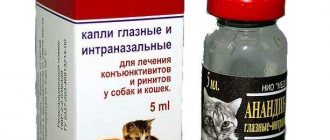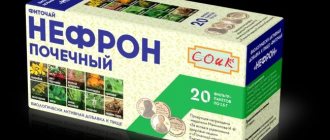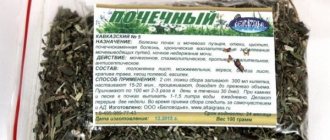Write a review
Reviews: 0
Manufacturers: Gedeon Richter Ltd., PL
Active ingredients
- Haloperidol
Disease class
- Mental and behavioral disorders caused by alcohol consumption - dependence syndrome
- Schizophrenia
- Delusional disorder
- Inorganic psychosis, unspecified
- Manic episode
- Somatization disorder
- Dissocial personality disorder
- Mental retardation, unspecified
- Behavioral disorders
- Combination of vocalisms and multiple motor tics [de la Tourette syndrome]
- Stuttering [stammering]
- Huntington's disease
- Nausea and vomiting
- Hallucinations, unspecified
Clinical and pharmacological group
- Not indicated. See instructions
Pharmacological action
- Neuroleptic
- Antiemetic
- Antipsychotic
Pharmacological group
- Neuroleptics
Solution for injections Haloperidol (Haloperidol)
Instructions for medical use of the drug
Description of pharmacological action
Blocks postsynaptic dopaminergic receptors located in the mesolimbic system (antipsychotic effect), hypothalamus (hypothermic effect and galactorrhea), trigger zone of the vomiting center, extrapyramidal system; inhibits central alpha-adrenergic receptors. Inhibits the release of mediators, reducing the permeability of presynaptic membranes, disrupts reverse neuronal uptake and deposition. Eliminates persistent personality changes, delusions, hallucinations, mania, and increases interest in the environment. Affects autonomic functions (reduces the tone of hollow organs, motility and secretion of the gastrointestinal tract, eliminates vascular spasms) in diseases accompanied by agitation, anxiety, and fear of death. Long-term use is accompanied by a change in endocrine status; in the anterior lobe of the pituitary gland, the production of prolactin increases and the production of gonadotropic hormones decreases.
Indications for use
Psychomotor agitation of various origins (manic state, mental retardation, psychopathy, schizophrenia, chronic alcoholism), delusions and hallucinations (paranoid states, acute psychosis), Gilles de la Tourette syndrome, Huntington's chorea, psychosomatic disorders, behavioral disorders in old age and childhood, stuttering , long-lasting and treatment-resistant vomiting and hiccups. For haloperidol decanoate: schizophrenia (maintenance therapy).
Release form
solution for intravenous and intramuscular administration 5 mg/ml; ampoule 1 ml contour plastic packaging (pallets) 5 cardboard pack 1; solution for intravenous and intramuscular administration 5 mg/ml; dark glass ampoule 1 ml contour cell packaging 10 cardboard pack 2; solution for intramuscular administration 5 mg/ml; 1 ml ampoule with ampoule knife, cardboard pack 10; solution for intramuscular administration 5 mg/ml; 1 ml ampoule with ampoule knife contour cell packaging 5 cardboard pack 1; solution for intramuscular administration 5 mg/ml; ampoule 1 ml contour cell packaging 5 cardboard pack 2; solution for intramuscular administration 5 mg/ml; ampoule 2 ml with ampoule knife contour cell packaging 5 cardboard pack 1; solution for intramuscular administration 5 mg/ml; ampoule 2 ml with ampoule knife contour cell packaging 5 cardboard pack 2; solution for intramuscular administration 5 mg/ml; 2 ml ampoule with ampoule knife contour plastic packaging (pallets) 5 cardboard pack 1; solution for intramuscular administration 5 mg/ml; ampoule 2 ml with ampoule knife contour plastic packaging (pallets) 5 cardboard pack 2; solution for intramuscular administration 5 mg/ml; 1 ml ampoule with ampoule knife contour plastic packaging (pallets) 5 cardboard pack 1; solution for intramuscular administration 5 mg/ml; 1 ml ampoule with ampoule knife contour plastic packaging (pallets) 5 cardboard pack 1;
Pharmacodynamics
Blocks postsynaptic dopaminergic receptors located in the mesolimbic system (antipsychotic effect), hypothalamus (hypothermic effect and galactorrhea), trigger zone of the vomiting center, extrapyramidal system; inhibits central alpha-adrenergic receptors. Inhibits the release of mediators, reducing the permeability of presynaptic membranes, disrupts reverse neuronal uptake and deposition. Eliminates persistent personality changes, delusions, hallucinations, mania, and increases interest in the environment. Affects autonomic functions (reduces the tone of hollow organs, motility and secretion of the gastrointestinal tract, eliminates vascular spasms) in diseases accompanied by agitation, anxiety, and fear of death. Long-term use is accompanied by a change in endocrine status; in the anterior lobe of the pituitary gland, the production of prolactin increases and the production of gonadotropic hormones decreases.
Pharmacokinetics
When taken orally, 60% is absorbed. Plasma protein binding - 92%. Tmax for oral administration - 3-6 hours, for intramuscular administration - 10-20 minutes, for intramuscular administration of a prolonged form (haloperidol decanoate) - 3-9 days (in some patients, especially in the elderly - 1 day ). Intensively distributed in tissue, because easily passes histohematic barriers, including the BBB. Vss is 18 l/kg. Metabolized in the liver, undergoes the first pass effect through the liver. A strict relationship between plasma concentrations and effects has not been established. T1/2 when taken orally - 24 hours (12-37 hours), with intramuscular administration - 21 hours (17-25 hours), with intravenous administration - 14 hours (10-19 hours), for haloperidol decanoate - 3 weeks (single or multiple doses). Excreted by the kidneys and bile.
Use during pregnancy
Contraindicated. Category of effect on the fetus according to the FDA is C. Breastfeeding should be discontinued during treatment (passes into breast milk).
Contraindications for use
Hypersensitivity, severe toxic depression of the central nervous system or coma caused by taking drugs; diseases of the central nervous system accompanied by pyramidal and extrapyramidal symptoms (including Parkinson's disease), epilepsy (the convulsive threshold may decrease), severe depressive disorders (symptoms may worsen), cardiovascular diseases with decompensation symptoms, pregnancy, breastfeeding, age up to 3 years.
Side effects
From the nervous system and sensory organs: akathisia, dystonic extrapyramidal disorders (including spasms of the muscles of the face, neck and back, tic-like movements or twitching, weakness in the arms and legs), parkinsonian extrapyramidal disorders (including difficulty speaking and swallowing, mask-like face, shuffling gait, tremor of hands and fingers), headache, insomnia, drowsiness, restlessness, anxiety, agitation, agitation, euphoria or depression, lethargy, epileptic seizures, confusion, exacerbation of psychosis and hallucinations, tardive dyskinesia (see " Precautionary measures"); visual impairment (including visual acuity), cataracts, retinopathy. From the cardiovascular system and blood (hematopoiesis, hemostasis): tachycardia, arterial hypotension/hypertension, QT interval prolongation, ventricular arrhythmia, ECG changes; there have been reports of cases of sudden death, prolongation of the QT interval and impaired RI (see "Precautions"); transient leukopenia and leukocytosis, erythropenia, anemia, agranulocytosis. From the respiratory system: laryngospasm, bronchospasm. From the gastrointestinal tract: anorexia, constipation/diarrhea, hypersalivation, nausea, vomiting, dry mouth, impaired liver function, obstructive jaundice. From the genitourinary system: engorgement of the mammary glands, unusual secretion of milk, mastalgia, gynecomastia, menstrual irregularities, urinary retention, impotence, increased libido, priapism. From the skin: maculopapular and acne-like skin changes, photosensitivity, alopecia. Other: neuroleptic malignant syndrome, accompanied by hyperthermia, muscle rigidity, loss of consciousness; hyperprolactinemia, sweating, hyperglycemia/hypoglycemia, hyponatremia.
Directions for use and doses
The dosage regimen is set individually. To relieve psychomotor agitation in adults - 5-10 mg IM or IV with possible one- or two-time repeated administration after 30-40 minutes. Orally, the initial dose for adults is 0.5-5 mg 2-3 times a day, then the dose is gradually increased until a stable therapeutic effect is obtained (on average up to 10-15 mg/day, for chronic forms of schizophrenia - up to 20-60 mg /day), followed by a transition to a lower maintenance dose. The maximum daily dose is 100 mg. The dose for children over 3 years of age is calculated according to body weight. Elderly and debilitated patients are prescribed a lower dose. Injection solution containing haloperidol decanoate - strictly intramuscularly, initial dose - 25-75 mg once every 4 weeks.
Overdose
Symptoms: severe extrapyramidal disorders, arterial hypotension, drowsiness, lethargy, in severe cases - coma, respiratory depression, shock. Treatment: there is no specific antidote. Gastric lavage and subsequent administration of activated charcoal are possible (if the overdose is associated with ingestion). In case of respiratory depression - mechanical ventilation, with a pronounced decrease in blood pressure - administration of plasma-substituting fluids, plasma, norepinephrine (but not adrenaline!), to reduce the severity of extrapyramidal disorders - central anticholinergic blockers and antiparkinsonian drugs.
Interactions with other drugs
Enhances the effect of antihypertensive drugs, opioid analgesics, antidepressants, barbiturates, alcohol, weakens the effect of indirect anticoagulants. Inhibits the metabolism of tricyclic antidepressants (their plasma levels increase) and increases toxicity. With long-term administration of carbamazepine, the plasma level of haloperidol decreases (the dose must be increased). In combination with lithium, it can cause an encephalopathy-like syndrome.
Precautions for use
Prescribe with caution to patients with epilepsy, severe cardiovascular pathology, predisposition to glaucoma, impaired liver function, thyrotoxicosis, pulmonary or renal failure. During treatment, it is not recommended to engage in activities that require increased concentration (driving a car, operating machine equipment, etc.).
Storage conditions
List B: In a dry place, protected from light, at a temperature not exceeding 25 °C.
Best before date
36 months
ATX classification:
N Nervous system
N05 Psycholeptics
N05A Antipsychotic drugs
N05AD Butyrophenone derivatives
N05AD01 Haloperidol
Haloperidol decanoate solution for intramuscular administration, oily 50 mg/ml ampoules of 1 ml 5 pcs.
Increases the severity of the inhibitory effect on the central nervous system of ethanol, tricyclic antidepressants, opioid analgesics, barbiturates and hypnotics, and agents for general anesthesia. Enhances the effect of peripheral m-anticholinergic drugs and most antihypertensive drugs (reduces the effect of guanethidine due to its displacement from alpha-adrenergic neurons and suppression of its uptake by these neurons). It inhibits the metabolism of tricyclic antidepressants and MAO inhibitors, thereby increasing (mutually) their sedative effect and toxicity. When used simultaneously with bupropion, it reduces the epileptic threshold and increases the risk of grand mal seizures. Reduces the effect of anticonvulsants (lowering the seizure threshold with haloperidol). Weakens the vasoconstrictor effect of dopamine, phenylephrine, norepinephrine, ephedrine and epinephrine (blockade of alpha-adrenergic receptors by haloperidol, which can lead to a distortion of the action of epinephrine and a paradoxical decrease in blood pressure). Reduces the effect of antiparkinsonian drugs (antagonistic effect on dopaminergic structures of the central nervous system). Changes (may increase or decrease) the effect of anticoagulants. Reduces the effect of bromocriptine (dose adjustment may be required). When used with methyldopa, it increases the risk of developing mental disorders (including disorientation in space, slowdown and difficulty in thinking processes). Amphetamines reduce the antipsychotic effect of haloperidol, which in turn reduces their psychostimulant effect (blockade of alpha-adrenergic receptors by haloperidol). Anticholinergic, antihistamine (first generation) and antiparkinsonian drugs can enhance the m-anticholinergic effect of haloperidol and reduce its antipsychotic effect (dose adjustment may be required). Long-term administration of carbamazepine, barbiturates and other inducers of microsomal oxidation reduces the concentration of haloperidol in plasma. In combination with Li+ drugs (especially in high doses), the development of encephalopathy (can cause irreversible neurointoxication) and increased extrapyramidal symptoms is possible. When taken simultaneously with fluoxetine, the risk of developing side effects from the central nervous system, especially extrapyramidal reactions, increases. When used simultaneously with drugs that cause extrapyramidal reactions, it increases the frequency and severity of estrapyramidal disorders. Drinking strong tea or coffee (especially in large quantities) reduces the effect of haloperidol.
Similar drugs:
- Eglonil Oral tablets
- Finlepsin Oral tablets
- Moditen depo Solution for intramuscular administration
- Egolanza Oral tablets
- Rispaksol Oral tablets
- Thiodazine Oral tablets
- Closasten (Closastene) Oral tablets
- Clopixol Depot Solution for intramuscular administration
- Thioridazine Oral tablets
- Leponex Oral tablets
** The Drug Directory is intended for informational purposes only. For more complete information, please refer to the manufacturer's instructions. Do not self-medicate; Before starting to use Haloperidol, you should consult a doctor. EUROLAB is not responsible for the consequences caused by the use of information posted on the portal. Any information on the site does not replace medical advice and cannot serve as a guarantee of the positive effect of the drug.
Are you interested in the drug Haloperidol? Do you want to know more detailed information or do you need a doctor's examination? Or do you need an inspection? You can make an appointment with a doctor - the Euro lab is always at your service! The best doctors will examine you, advise you, provide the necessary assistance and make a diagnosis. You can also call a doctor at home . Euro lab clinic is open for you around the clock.
** Attention! The information presented in this medication guide is intended for medical professionals and should not be used as a basis for self-medication. The description of the drug Haloperidol is provided for informational purposes and is not intended for prescribing treatment without the participation of a doctor. Patients need to consult a specialist!
If you are interested in any other drugs and medications, their descriptions and instructions for use, information about the composition and form of release, indications for use and side effects, methods of use, prices and reviews of drugs, or you have any other questions and suggestions - write to us, we will definitely try to help you.


